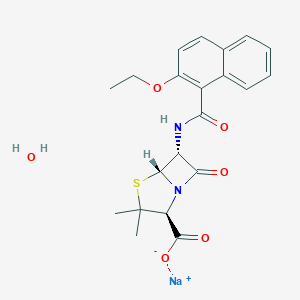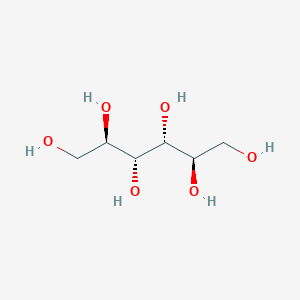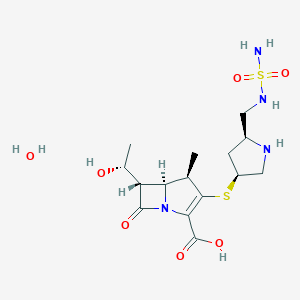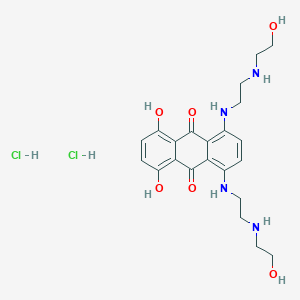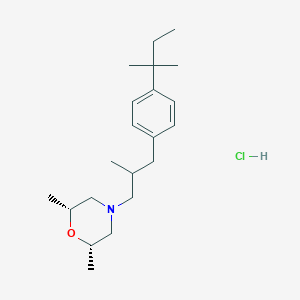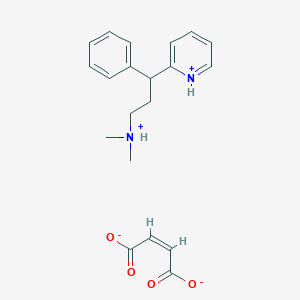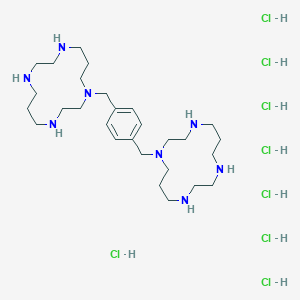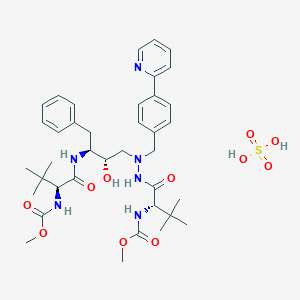
伊马替尼
概述
描述
Imatinib, sold under the brand names Gleevec and Glivec, is an oral targeted therapy medication used to treat various types of cancer. It is a small molecule inhibitor targeting multiple tyrosine kinases such as CSF1R, ABL, c-KIT, FLT3, and PDGFR-β . Imatinib is primarily used for chronic myelogenous leukemia (CML) and acute lymphocytic leukemia (ALL) that are Philadelphia chromosome-positive (Ph+), certain types of gastrointestinal stromal tumors (GIST), hypereosinophilic syndrome (HES), chronic eosinophilic leukemia (CEL), systemic mastocytosis, and myelodysplastic syndrome .
科学研究应用
Imatinib has revolutionized drug therapy for chronic myeloid leukemia (CML). It is used to treat CML, gastrointestinal stromal tumors (GISTs), and a number of other malignancies . In 2006, the FDA expanded its approved use to include dermatofibrosarcoma protuberans (DFSP), myelodysplastic/myeloproliferative diseases (MDS/MPD), and aggressive systemic mastocytosis (ASM) . Imatinib’s pharmacokinetic properties have been characterized, and it is well absorbed after oral administration, with a high protein binding rate .
作用机制
Target of Action:
Imatinib’s primary target is the BCR-ABL tyrosine kinase. This enzyme is constitutively active due to the Philadelphia chromosome abnormality found in chronic myeloid leukemia (CML). The BCR-ABL kinase drives uncontrolled cell proliferation and survival, contributing to the progression of CML .
Mode of Action:
Imatinib inhibits the BCR-ABL tyrosine kinase by binding to its active site. By doing so, it prevents the phosphorylation of downstream substrates, disrupting the signaling cascade that promotes cell growth and survival. Essentially, Imatinib puts the brakes on the abnormal protein’s activity, halting the division of cancer cells and inducing apoptosis (cell death) .
Biochemical Pathways:
The affected pathways include those related to cell cycle regulation, proliferation, and survival. By blocking BCR-ABL, Imatinib disrupts the ABL kinase’s overexpression seen in various tumors. This inhibition leads to downstream effects, ultimately curbing the growth of leukemic cells .
Pharmacokinetics:
Result of Action:
Imatinib’s action results in:
- Improved Survival : Enhanced overall survival in patients with Ph+ acute lymphoblastic leukemia and other indications .
Action Environment:
Environmental factors, such as drug interactions (e.g., CYP3A4 inhibitors), affect Imatinib’s efficacy and stability. Maintaining consistent drug levels is crucial for optimal therapeutic outcomes .
Remember, Imatinib’s success story exemplifies the power of targeted therapies tailored to individual cancer genetics. 🌿🧬 . If you have any more questions or need further details, feel free to ask!
生化分析
Biochemical Properties
Imatinib interacts with several enzymes and proteins. It is a tyrosine kinase inhibitor that targets multiple tyrosine kinases such as CSF1R, ABL, c-KIT, FLT3, and PDGFR-β . These interactions inhibit the tyrosine kinases, disrupting the signaling pathways they control, which can slow growth or result in programmed cell death of certain types of cancer cells .
Cellular Effects
Imatinib has significant effects on various types of cells and cellular processes. It influences cell function by impacting cell signaling pathways, gene expression, and cellular metabolism . For instance, it has been shown to switch from glycolysis to the tricarboxylic acid cycle, upregulate pentose phosphate pathway-associated oxidative pathways, and cause internal translocation of glucose transporters .
Molecular Mechanism
Imatinib exerts its effects at the molecular level primarily by inhibiting the Bcr-Abl tyrosine-kinase . This inhibition disrupts the signaling pathways controlled by these kinases, leading to slowed growth or programmed cell death of certain types of cancer cells .
Temporal Effects in Laboratory Settings
In laboratory settings, the effects of imatinib change over time. Imatinib is rapidly absorbed following oral administration, achieving pharmacologically relevant concentrations in the plasma, with a half-life of approximately 1.3 hours . It has been shown that continuous inhibition of BCR-ABL kinase activity is needed to achieve maximal antitumor effects .
Dosage Effects in Animal Models
The effects of imatinib vary with different dosages in animal models. For instance, once-daily intraperitoneal treatment using doses of imatinib from 2.5 to 50 mg/kg caused dose-dependent inhibition of tumor growth .
Metabolic Pathways
Imatinib is involved in several metabolic pathways. It is primarily metabolized by the CYP3A4 isoform of CYP450 . Other enzymes such as flavin-containing monooxygenase 3 (FMO3), and uridine 5’-diphospho-glucuronosyltransferase (UGT) also metabolize imatinib .
Transport and Distribution
Imatinib is transported and distributed within cells and tissues. It is the only tyrosine kinase inhibitor whose absorption depends on both influx (OCT1 and OATP1A2) and efflux (ABCB1 and ABCG2) transporters .
Subcellular Localization
Imatinib is sequestered in the lysosomes within cells . This lysosomal sequestration determines the intracellular levels of imatinib .
准备方法
The synthesis of Imatinib involves a classical convergent approach. The compound is assembled by coupling the amine and carboxylic acid precursors using N,N′-carbonyldiimidazole (CDI) as a condensing agent . The first synthesis of Imatinib, reported by Zimmermann, was based on the connection of two key intermediates: the aromatic amine and 4-[(4-methylpiperazin-1-yl)methyl]benzoyl chloride . Industrial production methods have been optimized to overcome certain problematic steps, save time and labor, and provide high yield and purity .
化学反应分析
Imatinib undergoes various types of chemical reactions, including oxidation, reduction, and substitution. Common reagents and conditions used in these reactions include hydrogen over Adam’s catalyst for reduction and CDI for condensation reactions . Major products formed from these reactions include various Imatinib analogues and impurities, which are characterized and confirmed using techniques such as IR, 1H-NMR, and Mass Spectrometry .
相似化合物的比较
Imatinib is compared with other tyrosine kinase inhibitors such as dasatinib, nilotinib, bosutinib, ponatinib, asciminib, and olverembatinib . These compounds are used to treat chronic myeloid leukemia (CML) and other malignancies caused by BCR-ABL, c-KIT, and PDGFR. Imatinib remains the most prevalent and frequently used for CML therapy due to its effectiveness and manageable adverse reactions . Generic versions of Imatinib have shown similar pharmacologic properties and efficacy compared to the original branded form .
属性
IUPAC Name |
4-[(4-methylpiperazin-1-yl)methyl]-N-[4-methyl-3-[(4-pyridin-3-ylpyrimidin-2-yl)amino]phenyl]benzamide | |
|---|---|---|
| Source | PubChem | |
| URL | https://pubchem.ncbi.nlm.nih.gov | |
| Description | Data deposited in or computed by PubChem | |
InChI |
InChI=1S/C29H31N7O/c1-21-5-10-25(18-27(21)34-29-31-13-11-26(33-29)24-4-3-12-30-19-24)32-28(37)23-8-6-22(7-9-23)20-36-16-14-35(2)15-17-36/h3-13,18-19H,14-17,20H2,1-2H3,(H,32,37)(H,31,33,34) | |
| Source | PubChem | |
| URL | https://pubchem.ncbi.nlm.nih.gov | |
| Description | Data deposited in or computed by PubChem | |
InChI Key |
KTUFNOKKBVMGRW-UHFFFAOYSA-N | |
| Source | PubChem | |
| URL | https://pubchem.ncbi.nlm.nih.gov | |
| Description | Data deposited in or computed by PubChem | |
Canonical SMILES |
CC1=C(C=C(C=C1)NC(=O)C2=CC=C(C=C2)CN3CCN(CC3)C)NC4=NC=CC(=N4)C5=CN=CC=C5 | |
| Source | PubChem | |
| URL | https://pubchem.ncbi.nlm.nih.gov | |
| Description | Data deposited in or computed by PubChem | |
Molecular Formula |
C29H31N7O | |
| Source | PubChem | |
| URL | https://pubchem.ncbi.nlm.nih.gov | |
| Description | Data deposited in or computed by PubChem | |
DSSTOX Substance ID |
DTXSID3037125 | |
| Record name | Imatinib | |
| Source | EPA DSSTox | |
| URL | https://comptox.epa.gov/dashboard/DTXSID3037125 | |
| Description | DSSTox provides a high quality public chemistry resource for supporting improved predictive toxicology. | |
Molecular Weight |
493.6 g/mol | |
| Source | PubChem | |
| URL | https://pubchem.ncbi.nlm.nih.gov | |
| Description | Data deposited in or computed by PubChem | |
Physical Description |
Solid | |
| Record name | Imatinib | |
| Source | Human Metabolome Database (HMDB) | |
| URL | http://www.hmdb.ca/metabolites/HMDB0014757 | |
| Description | The Human Metabolome Database (HMDB) is a freely available electronic database containing detailed information about small molecule metabolites found in the human body. | |
| Explanation | HMDB is offered to the public as a freely available resource. Use and re-distribution of the data, in whole or in part, for commercial purposes requires explicit permission of the authors and explicit acknowledgment of the source material (HMDB) and the original publication (see the HMDB citing page). We ask that users who download significant portions of the database cite the HMDB paper in any resulting publications. | |
Solubility |
Very soluble in water at pH < 5.5 (mesylate salt), 1.46e-02 g/L | |
| Record name | Imatinib | |
| Source | DrugBank | |
| URL | https://www.drugbank.ca/drugs/DB00619 | |
| Description | The DrugBank database is a unique bioinformatics and cheminformatics resource that combines detailed drug (i.e. chemical, pharmacological and pharmaceutical) data with comprehensive drug target (i.e. sequence, structure, and pathway) information. | |
| Explanation | Creative Common's Attribution-NonCommercial 4.0 International License (http://creativecommons.org/licenses/by-nc/4.0/legalcode) | |
| Record name | Imatinib | |
| Source | Human Metabolome Database (HMDB) | |
| URL | http://www.hmdb.ca/metabolites/HMDB0014757 | |
| Description | The Human Metabolome Database (HMDB) is a freely available electronic database containing detailed information about small molecule metabolites found in the human body. | |
| Explanation | HMDB is offered to the public as a freely available resource. Use and re-distribution of the data, in whole or in part, for commercial purposes requires explicit permission of the authors and explicit acknowledgment of the source material (HMDB) and the original publication (see the HMDB citing page). We ask that users who download significant portions of the database cite the HMDB paper in any resulting publications. | |
Mechanism of Action |
Imatinib mesylate is a protein-tyrosine kinase inhibitor that inhibits the BCR-ABL tyrosine kinase, the constitutively active tyrosine kinase created by the Philadelphia chromosome abnormality in CML.Although the function of normal BCR is still unclear, ABL activation is overexpressed in various tumors and is heavily implicated in cancer cells growth and survival. Imatinib inhibits the BCR-ABL protein by binding to the ATP pocket in the active site, thus preventing downstream phosphorylation of target protein. Imatinib is also an inhibitor of the receptor tyrosine kinases for platelet-derived growth factor (PDGF) and stem cell factor (SCF), c-Kit, and inhibits PDGF- and SCF-mediated cellular events. In vitro, imatinib inhibits proliferation and induces apoptosis in GIST cells, which express an activating c-Kit mutation. | |
| Record name | Imatinib | |
| Source | DrugBank | |
| URL | https://www.drugbank.ca/drugs/DB00619 | |
| Description | The DrugBank database is a unique bioinformatics and cheminformatics resource that combines detailed drug (i.e. chemical, pharmacological and pharmaceutical) data with comprehensive drug target (i.e. sequence, structure, and pathway) information. | |
| Explanation | Creative Common's Attribution-NonCommercial 4.0 International License (http://creativecommons.org/licenses/by-nc/4.0/legalcode) | |
CAS No. |
152459-95-5 | |
| Record name | Imatinib | |
| Source | CAS Common Chemistry | |
| URL | https://commonchemistry.cas.org/detail?cas_rn=152459-95-5 | |
| Description | CAS Common Chemistry is an open community resource for accessing chemical information. Nearly 500,000 chemical substances from CAS REGISTRY cover areas of community interest, including common and frequently regulated chemicals, and those relevant to high school and undergraduate chemistry classes. This chemical information, curated by our expert scientists, is provided in alignment with our mission as a division of the American Chemical Society. | |
| Explanation | The data from CAS Common Chemistry is provided under a CC-BY-NC 4.0 license, unless otherwise stated. | |
| Record name | Imatinib [INN:BAN] | |
| Source | ChemIDplus | |
| URL | https://pubchem.ncbi.nlm.nih.gov/substance/?source=chemidplus&sourceid=0152459955 | |
| Description | ChemIDplus is a free, web search system that provides access to the structure and nomenclature authority files used for the identification of chemical substances cited in National Library of Medicine (NLM) databases, including the TOXNET system. | |
| Record name | Imatinib | |
| Source | DrugBank | |
| URL | https://www.drugbank.ca/drugs/DB00619 | |
| Description | The DrugBank database is a unique bioinformatics and cheminformatics resource that combines detailed drug (i.e. chemical, pharmacological and pharmaceutical) data with comprehensive drug target (i.e. sequence, structure, and pathway) information. | |
| Explanation | Creative Common's Attribution-NonCommercial 4.0 International License (http://creativecommons.org/licenses/by-nc/4.0/legalcode) | |
| Record name | Imatinib | |
| Source | DTP/NCI | |
| URL | https://dtp.cancer.gov/dtpstandard/servlet/dwindex?searchtype=NSC&outputformat=html&searchlist=759854 | |
| Description | The NCI Development Therapeutics Program (DTP) provides services and resources to the academic and private-sector research communities worldwide to facilitate the discovery and development of new cancer therapeutic agents. | |
| Explanation | Unless otherwise indicated, all text within NCI products is free of copyright and may be reused without our permission. Credit the National Cancer Institute as the source. | |
| Record name | Imatinib | |
| Source | DTP/NCI | |
| URL | https://dtp.cancer.gov/dtpstandard/servlet/dwindex?searchtype=NSC&outputformat=html&searchlist=743414 | |
| Description | The NCI Development Therapeutics Program (DTP) provides services and resources to the academic and private-sector research communities worldwide to facilitate the discovery and development of new cancer therapeutic agents. | |
| Explanation | Unless otherwise indicated, all text within NCI products is free of copyright and may be reused without our permission. Credit the National Cancer Institute as the source. | |
| Record name | Imatinib | |
| Source | EPA DSSTox | |
| URL | https://comptox.epa.gov/dashboard/DTXSID3037125 | |
| Description | DSSTox provides a high quality public chemistry resource for supporting improved predictive toxicology. | |
| Record name | IMATINIB | |
| Source | FDA Global Substance Registration System (GSRS) | |
| URL | https://gsrs.ncats.nih.gov/ginas/app/beta/substances/BKJ8M8G5HI | |
| Description | The FDA Global Substance Registration System (GSRS) enables the efficient and accurate exchange of information on what substances are in regulated products. Instead of relying on names, which vary across regulatory domains, countries, and regions, the GSRS knowledge base makes it possible for substances to be defined by standardized, scientific descriptions. | |
| Explanation | Unless otherwise noted, the contents of the FDA website (www.fda.gov), both text and graphics, are not copyrighted. They are in the public domain and may be republished, reprinted and otherwise used freely by anyone without the need to obtain permission from FDA. Credit to the U.S. Food and Drug Administration as the source is appreciated but not required. | |
| Record name | Imatinib | |
| Source | Human Metabolome Database (HMDB) | |
| URL | http://www.hmdb.ca/metabolites/HMDB0014757 | |
| Description | The Human Metabolome Database (HMDB) is a freely available electronic database containing detailed information about small molecule metabolites found in the human body. | |
| Explanation | HMDB is offered to the public as a freely available resource. Use and re-distribution of the data, in whole or in part, for commercial purposes requires explicit permission of the authors and explicit acknowledgment of the source material (HMDB) and the original publication (see the HMDB citing page). We ask that users who download significant portions of the database cite the HMDB paper in any resulting publications. | |
Melting Point |
226 °C (mesylate salt) | |
| Record name | Imatinib | |
| Source | DrugBank | |
| URL | https://www.drugbank.ca/drugs/DB00619 | |
| Description | The DrugBank database is a unique bioinformatics and cheminformatics resource that combines detailed drug (i.e. chemical, pharmacological and pharmaceutical) data with comprehensive drug target (i.e. sequence, structure, and pathway) information. | |
| Explanation | Creative Common's Attribution-NonCommercial 4.0 International License (http://creativecommons.org/licenses/by-nc/4.0/legalcode) | |
| Record name | Imatinib | |
| Source | Human Metabolome Database (HMDB) | |
| URL | http://www.hmdb.ca/metabolites/HMDB0014757 | |
| Description | The Human Metabolome Database (HMDB) is a freely available electronic database containing detailed information about small molecule metabolites found in the human body. | |
| Explanation | HMDB is offered to the public as a freely available resource. Use and re-distribution of the data, in whole or in part, for commercial purposes requires explicit permission of the authors and explicit acknowledgment of the source material (HMDB) and the original publication (see the HMDB citing page). We ask that users who download significant portions of the database cite the HMDB paper in any resulting publications. | |
Synthesis routes and methods I
Procedure details









Synthesis routes and methods II
Procedure details






Synthesis routes and methods III
Procedure details








Synthesis routes and methods IV
Procedure details











Synthesis routes and methods V
Procedure details







Retrosynthesis Analysis
AI-Powered Synthesis Planning: Our tool employs the Template_relevance Pistachio, Template_relevance Bkms_metabolic, Template_relevance Pistachio_ringbreaker, Template_relevance Reaxys, Template_relevance Reaxys_biocatalysis model, leveraging a vast database of chemical reactions to predict feasible synthetic routes.
One-Step Synthesis Focus: Specifically designed for one-step synthesis, it provides concise and direct routes for your target compounds, streamlining the synthesis process.
Accurate Predictions: Utilizing the extensive PISTACHIO, BKMS_METABOLIC, PISTACHIO_RINGBREAKER, REAXYS, REAXYS_BIOCATALYSIS database, our tool offers high-accuracy predictions, reflecting the latest in chemical research and data.
Strategy Settings
| Precursor scoring | Relevance Heuristic |
|---|---|
| Min. plausibility | 0.01 |
| Model | Template_relevance |
| Template Set | Pistachio/Bkms_metabolic/Pistachio_ringbreaker/Reaxys/Reaxys_biocatalysis |
| Top-N result to add to graph | 6 |
Feasible Synthetic Routes
体外研究产品的免责声明和信息
请注意,BenchChem 上展示的所有文章和产品信息仅供信息参考。 BenchChem 上可购买的产品专为体外研究设计,这些研究在生物体外进行。体外研究,源自拉丁语 "in glass",涉及在受控实验室环境中使用细胞或组织进行的实验。重要的是要注意,这些产品没有被归类为药物或药品,他们没有得到 FDA 的批准,用于预防、治疗或治愈任何医疗状况、疾病或疾病。我们必须强调,将这些产品以任何形式引入人类或动物的身体都是法律严格禁止的。遵守这些指南对确保研究和实验的法律和道德标准的符合性至关重要。
